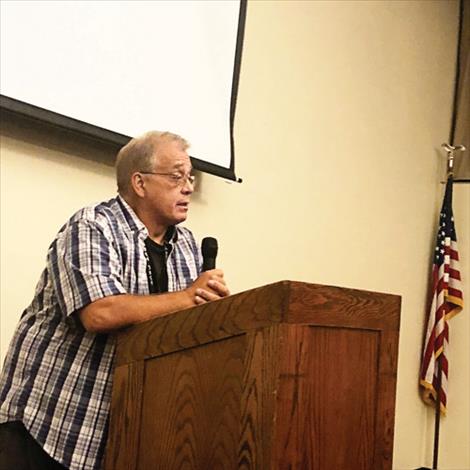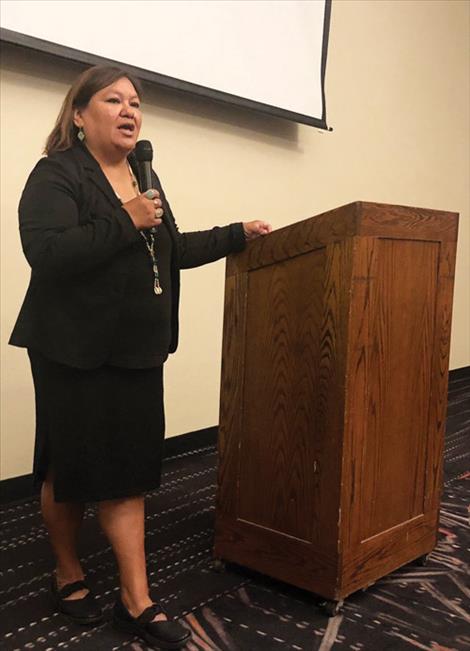State of the Tribes discusses impact of climate change on forest fires
Hey savvy news reader! Thanks for choosing local.
You are now reading
1 of 3 free articles.
“There is going to be a lot more fire on the landscape,” said Tribal Chairman Tom McDonald, who delivered the annual State of the Tribes address last Wednesday to the Polson Chamber of Commerce. He spoke as two fires were blistering the Flathead Reservation – one of which has consumed at least five homes, eight structures and more than 21,000 acres. The Elmo 2 fire comes just a year after the Boulder 2700 fire burned 2,230 acres and destroyed 31 structures along the east shore of Flathead Lake.
McDonald, who served as head of the CSKT Division of Fish, Wildlife, Recreation and Conservation before being elected to the Tribal Council in January, says climate change has been on the Tribes’ horizon for a long time.
“There have been warming periods, cooling periods through time in this locale – that cycle always existed,” he said. “But we’ve accelerated that cycle through our production of greenhouse gases. What you see right now is part of that effect.”
As a both a researcher and a former wildlands firefighter, McDonald has been attentive to the changes wrought by a warming climate. Several years ago, tribal researchers began looking at models by renowned University of Montana scientist Steven Running and a host of other climate experts “to see what the weather was going to be like here on the Flathead Reservation and in western Montana, to develop our climate-change strategy.”
At that time, summers were averaging 3-5 days of temperatures in the 100-degree range. “By 2050 that’s going to move to 30 days,” he said. “All the models are predicting that kind of change.”
With higher temperatures come stronger winds – a combination that’s already leading to unpredictable fire activity and much longer fire seasons. McDonald pointed to last December’s fire that swept through the small town of Denton, near Great Falls, and a fire in April 2021 west of Dixon, started by sparks along the Montana Rail Link line and fueled by wind gusts of 65 mph.
Curbing the proliferation of wildfires falls to humans, who cause the vast majority of them. “We’re in control of most of the fire starts,” McDonald said, urging more community education around fire prevention.
While climate models predict a similar amount of future precipitation for the reservation, moisture is apt to appear as rain instead of snow. Since snowpack is the major repository of water needed for irrigation, municipal water supplies and hydropower, “we have to think differently about how we capture rain and about rain events and how to manage water more carefully, more precisely,” he said.
The recent water compact settlement will help the Tribes and irrigators prepare for a changing future by financing a major overhaul of the aging irrigation system, which also traverses the state’s most active seismographic area. While the Tribes have been rebuilding dams through the Safety of Dams program, the compact allows them to also pay attention to the deteriorating delivery system.
According to McDonald, about 80% of the water ferried through the project’s earth-lined canals is lost to leakage. By repairing the labyrinth of canals, he anticipates that both irrigators and fisheries will benefit.
McDonald also stressed the importance of preventing Aquatic Invasive Species from taking hold in the watershed. “We take our responsibilities for the headwaters of the Columbia very seriously,” he said. “If we allow quagga mussels, zebra mussels to come in to Flathead Lake, it causes catastrophic failure all the way down the system,” with detrimental impacts to irrigation, hydropower and recreation.
The Tribes have worked with legislators to craft a three-layer approach to keeping AIS out of the watershed by monitoring watercraft at the state’s borders, at the Continental Divide and as boats enter the Flathead region. CSKT is lobbying for permanent checkpoints, much like weigh stations for trucks, and increased law enforcement to track down those who don’t stop at monitoring sites. “All it takes is one bad boat,” he added.
McDonald also addressed the recent hike in fees for permits to recreate on tribal lands. The increased fees and closure of some areas to non-members is the result of increased pressure on lands “that are essentially privately owned,” he said. “We do not receive federal funding to manage campgrounds or maintain hiking trails so what we do comes out of our own pockets.”
The influx of newcomers to the reservation has meant more people recreating on the river, lakes and trails, and in some cases, violating regulations. “Certain areas have a carrying capacity,” he added, using Going to the Sun highway in Glacier Park as an example. “Some of the areas we’ve been sharing in the past will probably be closed in the future because of the sheer number of people coming here.”
He noted, however, that places like the Bison Range, Flathead Lake, or wildlife areas managed for the federal government “will always be open to the public.”
Poet and journalist Jennifer Finley, another newcomer to the Tribal Council, also spoke about the Tribes responsibility to protect the reservation for future generations. As a council member, “my biggest role is to make sure that we continue to exist as a people and to take care of the land,” she told the audience. “Human beings have a short memory – 100 years from now no one will remember me, but 100 years from now I want CSKT tribal members to still be standing on the land that belongs to them.”
She noted that while many Americans struggle to find a connection to their past, to their ancestors, “for those of us who are not from someplace else, this is our homeland. All of our sacred stories, our places are here. Our biggest sense of belonging is here.”
The plight of Missing and Murdered Indigenous Women continues to impact Native people on this reservation and across the state. Finley pointed out that although Native Americans comprise only 6% of Montana’s population, they make up 35% of the missing/murdered people in the state (80% of those are women under 18). “For Native women, it’s a really dangerous world.”
Although the Tribes took a more aggressive approach so combatting COVID than either the county or state government, many tribal members lost their lives to the pandemic while others continue to struggle with health issues caused by the virus. “It changed the entire scope of work – some people are still working from home,” she said.
The pandemic also brought newcomers to the reservation, many of whom don’t understand the legal, historical and cultural implications of living here. The influx of new residents and tourists “really calls us to think of more ways, different ways to educate people about the fact that they are on tribal land and that the rules here, the laws here are different.”
“We are this place,” she said, “and this place is us.”

















